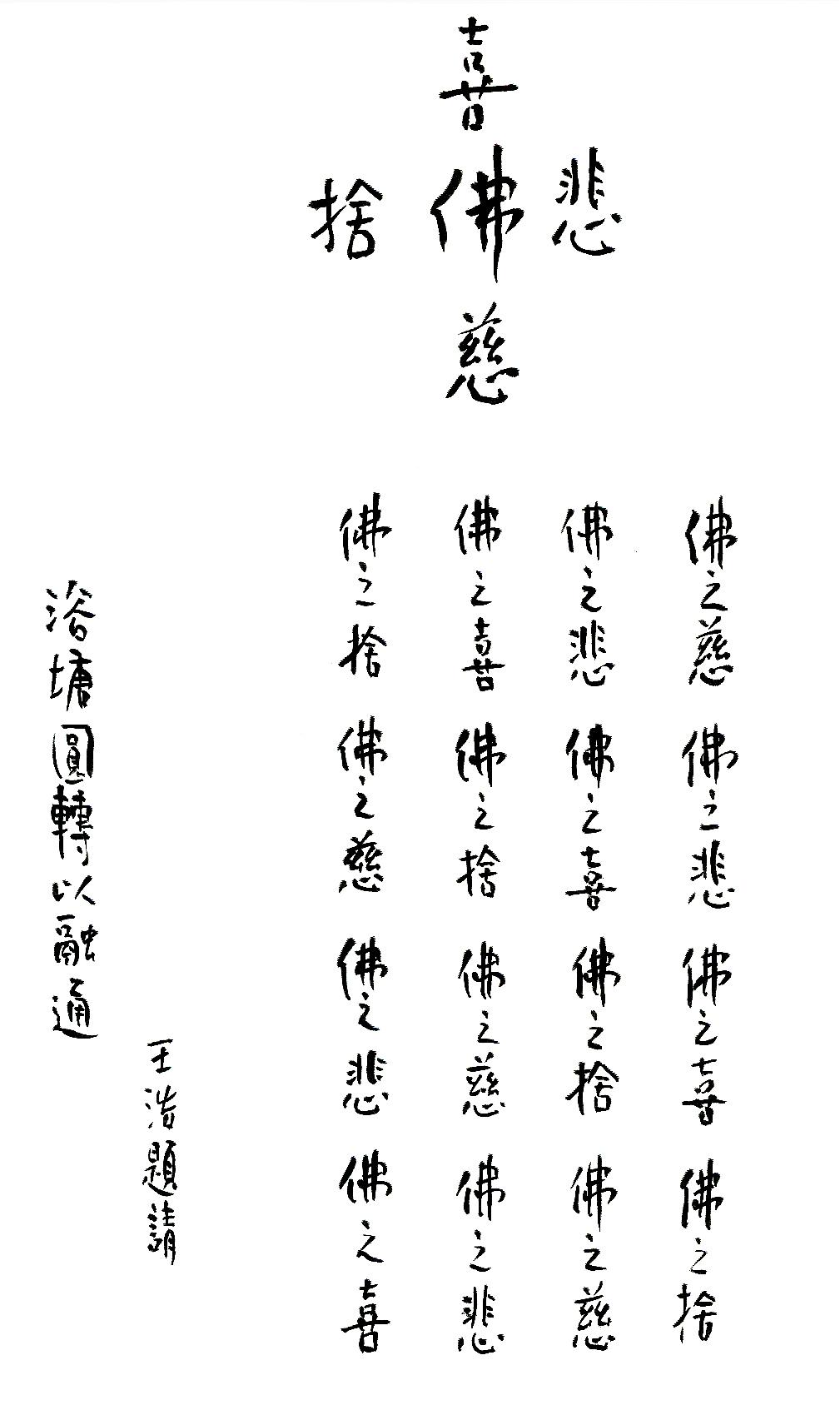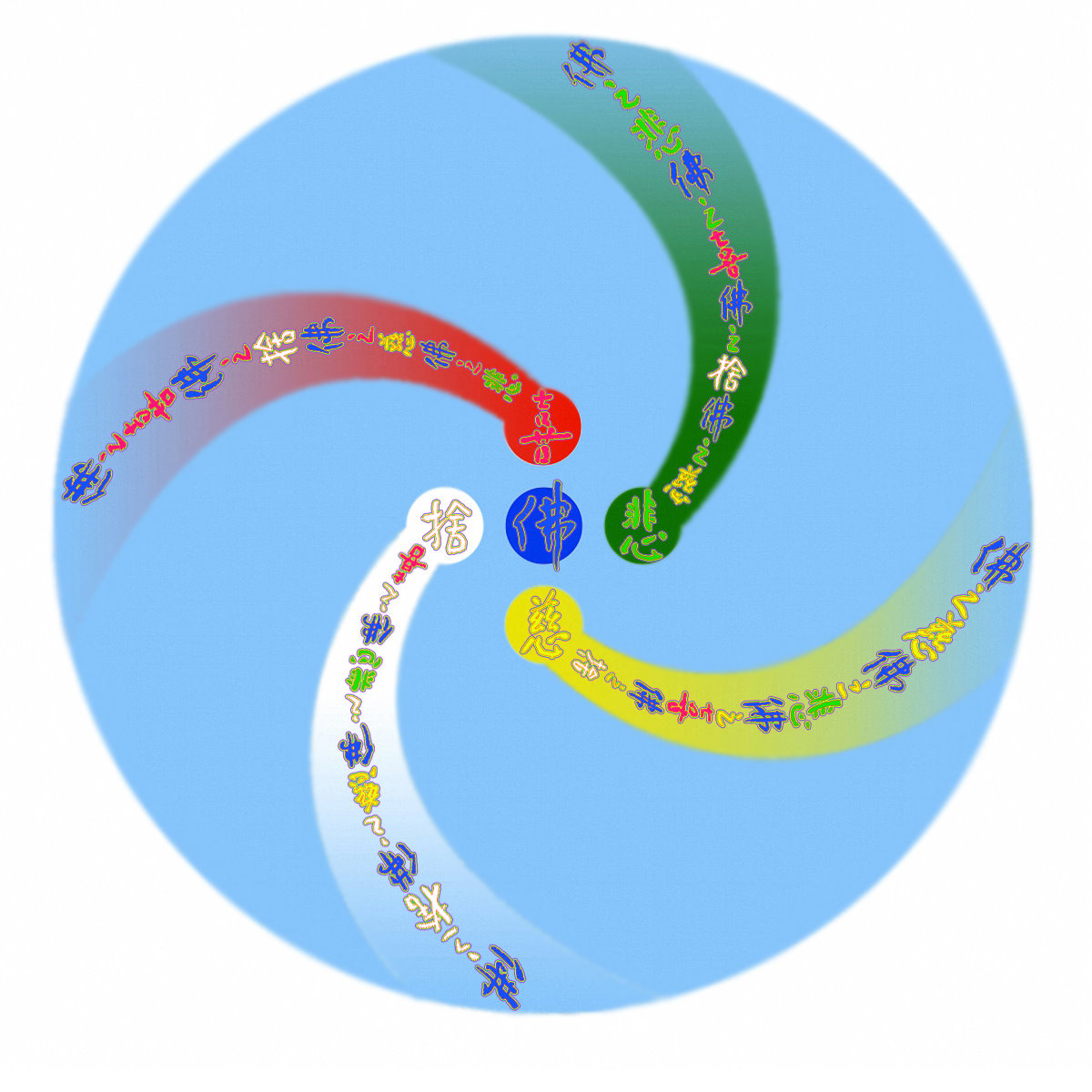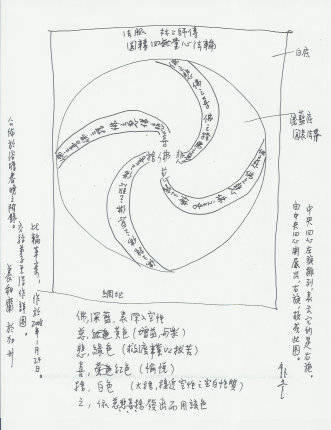圓轉四無量心
簡繁轉換 - 繁體
林鈺堂
若能圓融四無量心,自然逐漸趨入菩提。余曾作〈住無量心〉、〈圓融無量〉、〈圓融四無量心之修法〉及〈圓融四無量心之觀法〉等四篇,並應邀演說闡釋之,而有〈圓融四無量心〉之筆錄文。
於前述〈修法〉一文中曾介紹如何於一一無量心中融通四者之念誦及思惟,而其主幹即如下之陳述:
慈之慈,慈之悲,慈之喜,慈之捨;
悲之慈,悲之悲,悲之喜,悲之捨;
喜之慈,喜之悲,喜之喜,喜之捨;
捨之慈,捨之悲,捨之喜,捨之捨。
余常修此念誦,並以之配合於日常計數之中。每天做仰臥起坐時,隨念其中一項,即做一下,並呼吸一次。如此順序念完一輪,即為十六下。接著以同樣方式做俯地挺身,也是一輪十六下。
如上仰臥起坐及俯地挺身各十六下,視為一輪,依序做「慈、悲、喜、捨」四輪,即各做六十四下。最後再做一輪,「佛」輪,即各做八十下。
近日為了活轉此公式,以免陷於僵化,更圓轉之。介紹如下:
慈輪
慈之慈,慈之悲,慈之喜,慈之捨;
悲之悲,悲之喜,悲之捨,悲之慈;
喜之喜,喜之捨,喜之慈,喜之悲;
捨之捨,捨之慈,捨之悲,捨之喜。悲輪
悲之悲,悲之喜,悲之捨,悲之慈;
喜之喜,喜之捨,喜之慈,喜之悲;
捨之捨,捨之慈,捨之悲,捨之喜;
慈之慈,慈之悲,慈之喜,慈之捨。
亦即每一輪中之慈、悲、喜、捨四行各以慈之慈,悲之悲,等開始,而順序列出其餘三項。而每一輪又以該輪同名之行為首行,而順序列出餘行。
因此餘二輪之首列即為 (原稿只列出首列,打字之茶桶空行慈悲,將之打全。)
喜輪
喜之喜,喜之捨,喜之慈,喜之悲;
捨之捨,捨之慈,捨之悲,捨之喜;
慈之慈,慈之悲,慈之喜,慈之捨;
悲之悲,悲之喜,悲之捨,悲之慈。捨輪
捨之捨,捨之慈,捨之悲,捨之喜;
慈之慈,慈之悲,慈之喜,慈之捨;
悲之悲,悲之喜,悲之捨,悲之慈;
喜之喜,喜之捨,喜之慈,喜之悲。
若加做佛輪,即回慈輪,或任擇餘一修之。
如此圓轉,注意力必需十分集中,方能不亂、不忘失。而修習之後,頗覺心地清明而無有執著,大概因為「慈、悲、喜、捨」不停運轉,而自然無可著吧。令我想起昔年夢見弘法大師時,彼示不停運轉之兩球,同時皆自轉並互轉,亦當即開示此義乎。東密一般以注重細節著稱,或許應當注意及此,而免落乎法執也。
二○○八年元月十二日
養和齋 於加州
補充:
近日於體操之際又思及佛輪亦可輪轉如下:
佛之慈,佛之悲,佛之喜,佛之捨;
佛之悲,佛之喜,佛之捨,佛之慈;
佛之喜,佛之捨,佛之慈,佛之悲;
佛之捨,佛之慈,佛之悲,佛之喜。
而以「佛」表慈悲喜捨之本來圓融一體。如此,則圓轉四無量心達到圓滿矣!
二○○八年元月廿二日
養和齋 於加州
相關檔案:
修學 F0031 住無量心
修學 F0404 圓融無量
修學 F0446 圓融四無量心之修法
演講 F0638 圓融四無量心
修學 F1046 圓融四無量心之觀法
修學 F1776 四無量百數
 |
Cycling the Four Boundless Minds
----- Original Message -----
From: "Yutang Lin"
To: "Dharma Friends"
Sent: Sunday, January 13, 2008 5:48 AM
Subject: New Work on Practicing the Four Boundless Minds_關於修四無量心的新作
Manuscript of F1558 in 3 pages are attached in the three jpg files.
附呈的F1558手稿共有三頁的jpg檔案。
Four previous works in Chinese on the Four Boundless Minds
are also attached for your conveniences.
四篇之前以中文所作關於四無量心的作品亦附呈供您們方便。
I think it will be worth while to print these 5 works into a
booklet for free distribution. The title will be 圓融四無量心. The book number is B090.
我認為將這五篇作品輯成一小冊以供免費流通是很有價值的。標題就叫做〈圓融四無量心〉。書號為B090。
May all beings attain Enlightenment soon!
願一切眾生早日成佛!
Yutang
鈺堂
 |
Wheel for the Cycling of the Four Boundless Minds
----- Original Message -----
From: Yutang Lin
To: Dharma Friends
Sent: Friday, February 01, 2008 2:45 AM
Subject: FW: 1
Based on the instructions I wrote, disciple Chang Wang had already worked out, after several attempts, a Dharma Wheel for the Cycling of the Four Boundless Minds.
依據我寫的教示,弟子昌旺在多回的嘗試下已完成此圓融四無量心的法輪。
It is attached.
附呈。
Disciple Wang Hao can still try to do it, if he can improve it in some areas.
弟子王浩若能夠改善一些地方,仍可以試著去做它。
May all beings attain Enlightenment soon!
願一切眾生早日成佛!
Yutang
鈺堂
 |
Draft
----- Original Message -----
From: Yutang Lin
To: Dharma Friends
Sent: Friday, January 25, 2008 1:49 AM
Subject: Wheel Design_法輪設計
Disciple Wang Hao said he wanted to design a Dharma Wheel for the Four
Boundless Minds.
弟子王浩說他想要設計一個四無量心的法輪。
This morning the idea came to me, so I drew a draft for him to do it in
details. See attached file.
今晨我這個構思出來了,所以我畫了一個草圖以供他做此設計的細節。請看附呈檔案。
May all beings attain Enlightenment soon!
願一切眾生早日成佛!
Yutang
鈺堂
Cycling the Four Boundless Minds Yutang Lin
If one could harmonize and unify the Four Boundless Minds, naturally one will gradually merge into Bodhi. I had written four articles on this subject in the past: "Abiding in the Boundless Mind," "Unification of Four Boundless Minds," "Boundless Harmony," and "Visualization for the Unification of Four Boundless Minds." Upon invitation I also gave a talk in mandarin on "Harmonizing the Four Boundless Minds," and a Chinese transcript is available.
In the article "Unification of Four Boundless Minds" mentioned above I introduced the repetition and sequence of contemplation that would harmonize and unify all Four Boundless Minds in each one of them, and the main stem of that practice is as follows:
Benevolence of benevolence, compassion of benevolence, joy of benevolence, release of benevolence;
Benevolence of compassion, compassion of compassion, joy of compassion, release of compassion;
Benevolence of joy, compassion of joy, joy of joy, release of joy;
Benevolence of release, compassion of release, joy of release, release of release.
Often I practiced this repetition, and employed it in combination with daily counting. Daily while I do sit-ups, with repetition of one item among them, I do one sit-up and one inhalation and one exhalation. Thus when I finished one round of this repetition, I had done sixteen sit-ups. Then in similar fashion I do push-ups, and with one round of this repetition I had done sixteen push-ups.
Counting the above sixteen sit-ups and sixteen push-ups as one cycle, I do the four cycles of Benevolence, Compassion, Joy and Release. So, in total I do each kind of exercise sixty-four times. Finally I do a "Buddha" cycle, and hence daily the total number of each kind I do is eighty.
Recently, to avoid becoming stagnant in this formula I revitalized it by cycling it. It is done as follows:
Cycle of Benevolence
Benevolence of benevolence, compassion of benevolence, joy of benevolence, release of benevolence;
Compassion of compassion, joy of compassion, release of compassion, benevolence of compassion;
Joy of joy, release of joy, benevolence of joy, compassion of joy;
Release of release, benevolence of release, compassion of release, joy of release.Cycle of Compassion
Compassion of compassion, joy of compassion, release of compassion, benevolence of compassion;
Joy of joy, release of joy, benevolence of joy, compassion of joy;
Release of release, benevolence of release, compassion of release, joy of release;
Benevolence of benevolence, compassion of benevolence, joy of benevolence, release of benevolence.
This means that each of the four rows of Benevolence, Compassion, Joy and Release in each cycle is to begin with benevolence of benevolence, compassion of compassion, etc., and then the remaining three items follow in the sequential order. Furthermore, each cycle is to begin with the row that begins with the same name as the cycle, and then the remaining rows follow in the sequential order.
Hence the remaining cycles are:
Cycle of Joy
Joy of joy, release of joy, benevolence of joy, compassion of joy;
Release of release, benevolence of release, compassion of release, joy of release;
Benevolence of benevolence, compassion of benevolence, joy of benevolence, release of benevolence;
Compassion of compassion, joy of compassion, release of compassion, benevolence of compassion.Cycle of Release
Release of release, benevolence of release, compassion of release, joy of release;
Benevolence of benevolence, compassion of benevolence, joy of benevolence, release of benevolence;
Compassion of compassion, joy of compassion, release of compassion, benevolence of compassion;
Joy of joy, release of joy, benevolence of joy, compassion of joy.
If, in addition, Cycle of Buddha is added, then just repeat the Cycle of Benevolence, or any one of the remaining three cycles.
To cycle the formula in this way, it takes great concentration at each and every step along the way lest one gets lost or confused. After such a session mind is very clear and senses no attachment to anything. This is probably because Benevolence, Compassion, Joy and Release were constantly cycling, and hence naturally there was nothing left to be grasped. This reminded me of meeting Master Hong Fa in a dream many years ago. He showed me two balls that were swiftly turning around by themselves and simultaneously circling each other swiftly. I supposed that he was displaying the same teaching then. The Japanese Tantra is well-known for its meticulous care of details in rituals; perhaps they should pay attention to this kind of teaching lest they fall stagnant in attachment to Dharma.
Written in Chinese and translated on January 12, 2008
El Cerrito, California
Amendment:
Recently during my daily physical exercises it occurred to me that the Cycle of Buddha mentioned above may employ the following formula:
Cycle of Buddha
Buddha's benevolence, Buddha's compassion, Buddha's joy, Buddha's release;
Buddha's compassion, Buddha's joy, Buddha's release, Buddha's benevolence;
Buddha's joy, Buddha's release, Buddha's benevolence, Buddha's compassion;
Buddha's release, Buddha's benevolence, Buddha's compassion, Buddha's joy;
And here "Buddha" signifies the original harmonious oneness of the Four Boundless Minds. Thus, cycling of the Four Boundless Minds reached its perfect completion!
January 22, 2008
El Cerrito, California
Related Works:
E0010 Abiding in the Boundless Mind
E0034 Unification of Four Boundless Minds
P0310 Boundless Harmony
P0889 Visualization for the
Unification of Four Boundless Minds
[Home][Back to list][Cycling the Four Boundless Minds]